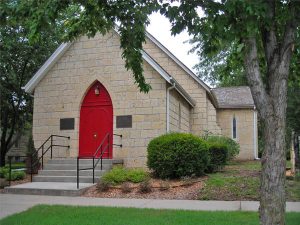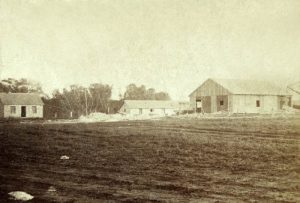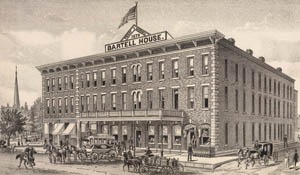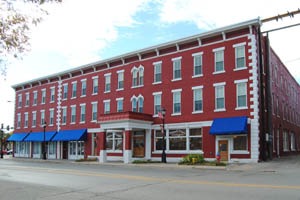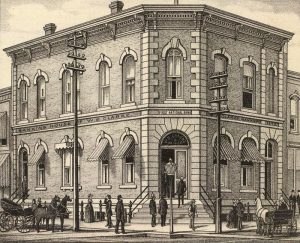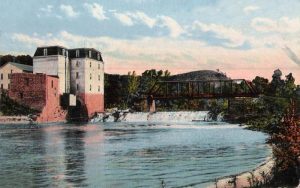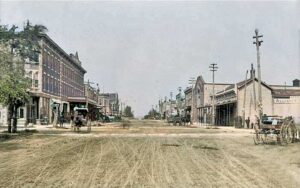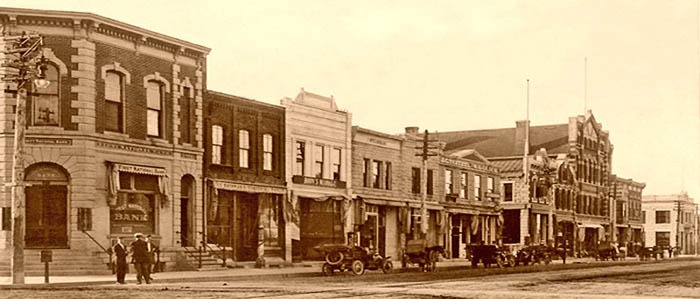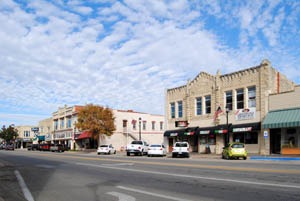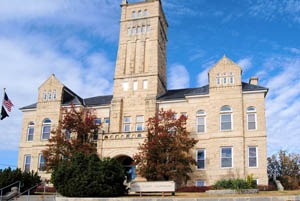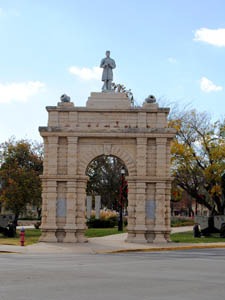Junction City, Kansas, the Geary County seat, is located in the west-central part of the county. It takes its name from its location at the confluence of the Smoky Hill and Republican Rivers, which form the Kansas River.
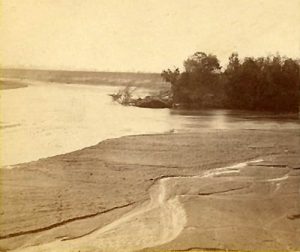
The junction of the Smoky Hill and Republican Rivers near Junction City, Kansas, by Alexander Gardner, 1867.
The site was first occupied by the Kanza Indians, who lived here as late as 1856 when many died from cholera.
In 1853, the government built a truss bridge across the Republican River, which was carried off by flooding in 1856, and in the year following, another one was built, which was carried away in 1858, and the railroad bridge made the third.
There were three towns planned for the location at the confluence of the rivers before Junction City was established. In 1855, organizers sent supplies via steamboat to build the proposed town of Manhatten, but the steamboat Hartford instead went aground near the newly established town of New Boston, and residents there agreed to change the name to Manhatten.
Captain Millard of the Hartford managed to get his steamboat free and make it to the original proposed site, which he then named Millard, but was only a town on paper. Another failed town of Humbolt followed about a year later, but again never took off.
In 1857, a town company was formed by J. R. McClure, Robert Wilson, F. N. Blake, John T. Price, and P. Z. Taylor, who selected the site. A survey was done in the spring of 1858. The town company erected the first building in May of that year at Seventh and Washington Streets. The first store opened in the city was by L. J. Harris in May 1858, and a post office was established in the building on June 30 with Harris as postmaster. The first newspaper published in the city or county was the Sentinel, edited by B. H. Keyser, with the first issue circulated in June 1858. More buildings rapidly followed. Within a few months, a village had grown up.
Junction City was incorporated as a city of the second class on February 9, 1859. In April 1859, F. N. Blake and E. S. Stover started a Sabbath school. The first city officers were elected in July 1859, with R. C. Whitney as mayor. On October 6, 1859, the United States Land office was moved from Ogden to Junction City. Late that year, Casper Bundle moved from Ogden and opened the first hotel.
In May 1859, work commenced on the Episcopal Church, the first church erected in the town. Located at 314 N Adams, it is the oldest Episcopal Church in continuous use in Kansas today. The town would eventually also have several other churches, including the German Methodist Church, Catholic, Baptist, Methodist, Presbyterian, African Methodist, Colored Baptist, Universal Church, and Congregational.
On June 25, 1859, an election was held regarding the location of the Geary County Seat, and Junction City received more than half the votes. In 1860, the city had a population of 1,118.
In November 1861, Streeter & Strickler commenced work on a two-story brick building at Washington and Sixth streets. This was the first brick building erected in the town.
Mrs. McFarland opened the first school in town on April 7, 1862. A few months later, a school district was organized in July 1862, and a public school opened on December 10, 1862.
In August 1863, George H. Purinton opened the “City Hotel,” the third hotel in the city. Soon afterward, the town’s first bank was founded, and several businesses offering a full line of products and services were established.
On May 16, 1866, the cornerstone of the Trott Brothers building was laid on Washington Street. In October, the Kansas Pacific Railroad depot grounds were marked off, and a turn table was erected. As the railway neared the city, newcomers crowded in by the score until there were neither hotel accommodations nor house-room for them. This was an exceedingly prosperous year for the town, and many houses sprang up. In November, trains began to run from Leavenworth to Junction City, and a new era opened up. Junction City was also made the end of the first division of the Kansas & Pacific Railroad, and soon a roundhouse, workshops, and a depot were built.
In December, the “Hale House” was completed, the commodiousness of which added greatly to the hotel accommodations of the town. The house opened for business on the morning of February 4, 1867, under the proprietorship of McMeekin & Dougher. Sixty men were served breakfast on the morning of its opening, 27 regular boarders were registered, and the first day’s business closed with 45 arrivals.
Within no time, Junction City became an outfitting point for westward expansion. From here, travelers and traders would make their way west along the Santa Fe, Oregon, and California Trails.
At about this same time, the Junction City Stone Sawing Company was established and secured a contract to provide stone for the State Capitol in Topeka. Most early buildings in Junction City were frame construction, but some brick business buildings were constructed with brick shipped by rail. However, in the 1860s, limestone was being quarried from the river bluffs around Junction City. The formation of the stone sawing company and others that followed served as the impetus for constructing limestone buildings for years to come.
Sargent Drug Store was also established in 1865, a frame structure on Washington Street. Other merchants included P.Z. Taylor’s dry goods, H. Hineman’s liquor, and tobacco, and Hall and Porter Drug Store, among others.
In February 1867, the railroad bridge across the Republican River was carried away by high water. It was the third bridge that had been carried away in 14 years. That year a $17,500 bridge was built by the county across the Smoky Hill River and one by the state across the Republican River.
On September 5, 1867, the cornerstone of the Union Pacific Railroad was laid amongst much celebration. Five days later, the cornerstone of the Methodist Church was laid.

Junction City, Kansas, 1874. Touch of color by LOA.
At about that same time, Junction City became a secondary shipping point for the cattle trade. Though it doesn’t appear to have taken on the characteristics of other typical Kansas cowtowns, it was a secondary shipping point to the more popular cowtown of Abilene for several years.
In October 1869, the Kansas Pacific Railroad sold the roundhouse, workshops, depot, and 30 acres of ground to the Union Pacific Railroad. On April 3, 1870, the division was changed from Junction City to Wamego. That year, Junction City had a population of 2,778.
On June 23, 1871, Junction City suffered from a terrible fire, which destroyed several buildings on the northwest corner of Seventh and Washington Streets. On July 18, a proposition was submitted to the city’s voters, asking for $30,000 to build a new schoolhouse, which the people rejected. In August of the same year, another proposition was submitted, asking for $10,000 for the same purpose, which was agreed to by a large majority. The schoolhouse was finished in October 1872 and was dedicated on November 18.
In February 1873, trains on the Junction City & Fort Kearney Railway commenced making regular trips from Junction City to Clay Center.
On April 13, 1874, a fire broke out in the “Hale House,” which stood on Washington Street, and spread rapidly. Although every effort was made to check its progress, the Hale House, Brown’s Hall, and eight or nine other buildings were destroyed before it could be extinguished.
Soon afterward, the grasshopper plague followed, which dealt a severe blow to Junction City and devastated the entire State. However, the city bravely survived and, by the end of 1875, was once again on the high road to prosperity.
The two and three-story red brick Bartell House hotel was built in 1878 on the same site as where the Hale House had stood. Designed by E.T. Carr, the Bartell House was constructed by local businessmen A.H. Bartell and John K. Wright to replace the Hale House. The brick building with limestone detailing combined the Italianate and Romanesque styles. It featured 66 rooms, a kitchen, parlors, offices, and a dining room with murals painted by Junction City artist Bertrand Hartman. Street-level shops spanned Washington and 6th Streets. Over the years, these spaces included the post office, a barbershop, a cigar shop, a candy shop, a music store, a drug store, and others. The Bartell House opened for business in January 1879. The city also had another excellent hotel called the Pacific House, a frame building of good size described as “neatly and comfortably furnished and well kept.”
By 1880, Junction City’s population had fallen to 2,684 due to railroad changes, the grasshopper plague, and the great panic of 1873. However, it would begin to grow again, with several substantial buildings and businesses established in the following years.
A city hall, which cost $28,000, was begun in 1880. An accident that destroyed a part of the building brought the total cost to $30,000 at completion. A magnificent brick building that served as a City Hall and public Opera House was completed in the fall of 1881.
Soon a courthouse was built, and though it was made of stone, it was considered inferior. It would not be too many years before it was replaced. In 1882, the student population had outgrown its first school, and a new larger one was built.
By the early 1880s, most buildings were built of stone or brick, and many were large. Businesses included multiple retail stores, including dry goods, clothing, hardware, boots and shoes, drugs, groceries, millinery, jewelry, books and stationery, and furniture. The town also boasted several other inferior hotels, all combined capable of furnishing ample accommodations for every occasion. The city had nine churches and a beautiful city park.
The 1880s brought technological advancements to the town along with prosperity, including stone sidewalks and paved streets. In 1896, Wright and Bartell, the owners of the Bartell House, decided their hotel needed a sewer; it was the first installed in the city.
In 1897, Cornelius Fogart, who owned a grist mill on the Smoky Hill River, began producing electricity and flour. He soon convinced the City to allow him to install street lights downtown. That same year, Bell Telephone installed telephones in the Courthouse and some local businesses. Within two years, the subscriber list grew to over 100.
On May 20, 1899, a new Geary County Courthouse was commissioned. It was designed by J.C. Holland and built by Ziegler and Dalton’s local construction firm. The magnesium limestone was quartered in the nearby bluffs, and the 3-1/2 story yellow-colored limestone and concrete Romanesque structure was completed in 1900 at $35,000. Located at 138 East 8th Street, the building retains a high degree of architectural and historical integrity and contributes to the Junction City Downtown Historic District.
In 1900, Junction City was called home to 4,695 people. Before that time, Bell Telephone had a monopoly, but in 1900 the City awarded a competing franchise to H.P. Wareham of Manhattan, representing an independent company. Wareham offered reduced rates which resulted in everyone who wanted one having a phone within the following year.
Shortly after the turn of the century, the City built an electric plant, the Junction City Electric Railway, and the Light and Ice Company. This venture also resulted in developing a trolley system, providing streetcar transportation between Fort Riley and Junction City that averaged 500 passengers daily.
The Bartlett House prospered in the early years but needed updating by the turn of the century. In 1902 Adolphus Busch of Saint Louis, Missouri, purchased the hotel and financed a significant remodeling and expansion. In the following years, the hotel reportedly maintained a discreet bar in the basement and eventually established a reputation as a house of ill-repute. As lawmakers cracked down on prostitution on 9th Street, the saloon and “soiled doves” only moved to other locations, including back to the Bartell House.
By 1910, Junction City boasted the Union Pacific and the Missouri, Kansas & Texas Railway. It was connected by an electric railway with Fort Riley, one of the most important military posts in the United States. The city was lighted by electricity and had waterworks, a fire department, and a sewer system. It also had fine county and city buildings constructed from native materials, an opera house, a high school, a German Lutheran school, the Catholic St. Francis Xavier school, numerous churches, three newspapers — the Union, the Republic, and the Sentinel, four banks, several grain elevators, two flour mills, an ice plant, a creamery, machine shops, carriage and wagon works, and a large number of retail establishments. Its post office had seven rural routes. The population in 1910 was 5,598.
These boom years in Junction City extended to World War I. Junction City’s prosperity was based on its position as the Geary County seat, supplier to Fort Riley, and a stock-raising, wheat-growing center. However, Kansas became a “dry” state and prohibited the production or sale of alcohol. Although local officials had some control, Junction City ignored the state law, allowed their saloons to continue operation, and even issued a license for an annual fee. The saloon business attracted soldiers at Fort Riley, and the City did not want to give up the income created by these establishments. By 1901, liquor was no longer served on the post, and traffic boomed in Junction City. However, in 1906, the Kansas Attorney General filed suit against Junction City, Atchison, Pittsburg, and Kansas City for violating the prohibition laws. This surprised local officials, but they did not protest the ruling.
During these years, Fort Riley grew, and Junction City responded by investing in many local improvements. In the meantime, the Bartlett Hotel building was sold to the Lamar Hotel chain, which operated it for the next 30 years. Although closely tied to the railroad in its early years, the end of passenger service and the evolution of the interstate highway system would cause the hotel to decline in the next years to the point that it had challenges with prostitution and a growing disreputable clientele.
By the early 1920s, the wartime boom had dried up, and Junction City’s support structure was reduced. Little development occurred in the next years, and soon the Great Depression had the same impact on Junction City as it did on the rest of the nation.
In 1923, John R. Brinkley established Radio Station KFKB, which stood for “Kansas First, Kansas Best,” using a 1 kW transmitter. It is one of the first radio stations in Kansas, if not the very first. Brinkley used the station to espouse his belief that goat testicles could be implanted in men to enhance virility. His practice was so successful that Brinkley soon had clinics and hospitals in several states. In the end, his medical license was revoked, and Federal Radio Commission refused to renew his station’s broadcasting license. He moved to Del Rio, Texas, where it was discovered that he had no formal medical training and was sued for malpractice,
In 1930, the city had a population of 7,407. Despite the economic challenges of the Great Depression, several public buildings were constructed during this period, often through Works Progress Administration. Some of these were a new U.S. Post Office, a new Municipal Building that housed City Hall, police and fire services, and a new public auditorium.
World War II brought another boom to the city. The Coca-Cola Bottling Company was constructed in 1941 on Jefferson Street and expanded in 1955. In the following years, Junction City continued to experience growth, and many of the existing downtown buildings were updated. At that time, the construction of Milford Lake north of the city was beginning, Interstate 70 had been paved, and Fort Riley was again expanding.
“There’s never been a time when the prospects for the future were as bright as they are now.” — Chamber of Commerce Chairman in 1961
By the mid-1970s, passenger service on the railroad ended. By this time, prostitution had again become a public issue that ended the Bartell House’s glory days. Such activities were concentrated on East 9th Street, and the City condemned the buildings around the depot in the name of urban renewal. However, when these buildings were cleared, the illegal activities dispersed downtown, including the Bartell House and the saloons along Washington Street. New hotel owners struggled and were prohibited from refusing customers under new anti-discrimination laws. Thus, they are unable to control prostitution in the hotel. Ultimately, the Fire Marshal condemned the hotel’s upper floors; the hotel closed, and the building was sold at a tax auction. Today, the building serves senior residents.
Junction City’s population peaked at 23,353 in 1910. Today, it is called home to about 21,500 people.
The Junction City Downtown Historic District is located in the northeast quarter of the city. Encompassing about 5.5 blocks or 20 acres, most historic commercial buildings are within the central business district. The depot and a strip of old commercial structures, known as Bowery Row, were originally located around the depot northeast of the Courthouse.
© Kathy Alexander/Legends of Kansas, updated December 2024.
Sources:
Blackmar, Frank W.; Kansas: A Cyclopedia of State History, Vol I; Standard Publishing Company, Chicago, IL 1912.
Cutler, William G; History of Kansas; A. T. Andreas, Chicago, IL, 1883
Junction City Mainstreet
National Historic District Nomination
Junction City, Kansas
Wikipedia


